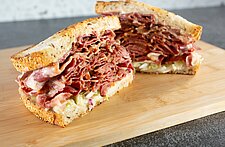These topics may not have been as “front of the house” at the 9th Annual StarChefs International Chefs Congress, but in talking to various chefs, they’re still just as important.
- Spotlight On Charcuterie: The “Rise of Charcuterie” was discussed at last year’s conference (reference to last year’s post) and continues to be a big part of a chef’s repertoire, especially those in this year’s Southern Showcase where cured meats (hello pork!) took center stage. An added element this conference: Talk of pairing the meats with nuts and fruits. Brad Smoliak of Canada’s Brad Kitchen in Edmonton says the fruits and nuts help pick up the flavor of the meats, not to mention look nice on the plate.
- Waste Not, Want Not: Dan Barber of New York’s Blue Hill and Blue Hill at Stone Barn is all about “using the whole farm,” finding a use for everything while Jamie Pesaque of Lima’s Mayta admitted there’s always a sauce or marinade to be made from a fish head to pig intestines. Jamie Bissonette of Boston’s Toro said saving money certainly plays a part in his sustainability quest, but more than that, it’s respect for the how those ingredients got to his cutting board.

- Inspiration From Travel: Countless chefs talked about getting their inspiration for new ingredients and flavors from their travels. Chef Joseph (J.J.) Johnson of The Cecil in New York says he’s definitely pushing the envelope with his West African and Caribbean-inspired flavors. Served at the Product Showcase, what he calls “Afro-Asian cuisine”: Oxtail Dumplings, Green Apple curry and Taro Root.
- Telling A Story. The sense of story was a repeated refrain during the conference with many participants saying their personal history gives them inspiration. George Mendes of Aldea in New York said it was his family’s roots in Portugal – and his mom’s Old World cooking – that defined his cooking style while Ryan McCaskey of Acadia in Chicago says he has “a love affair with Maine,” where he spent 14 summers as a child. The menu at Acadia, named after the national park there, tells this story and “people like it,” he says, “because there’s a connection there.”
- Adding New Ethnicities To The Mix: Chef Dave Omar of Zinc in Edmonton sees a big Vietnam influence coming into play, along with Moroccan and North African flavors including ingredients such as cumin, fruit and nut combinations, and utilizing tagine cooking methods. At the moment his ingredients of choice are tongue and beef cheeks, though he says he’s also enjoying experimenting with pistachio oil. Chef Isidori's of New York’s Chalk Point Kitchen's says he’s all about multicultural influences, while at the same time being dedicated to local sources. “Think Chinatown meets Union Square’s Green Market,” he said of the Korean-style mussels that were a huge hit at the Product Showcase.
- “More Than a Restaurant:” Being part of the community is a key factor in the success of New York’s Red Rooster, explained Chef Marcus Samuelsson whose restaurant has led to the renaissance of growth in Harlem. Being respectful of the neighborhood, in his case hiring within the community and adding music to tie into Harlem’s traditional jazz culture, was a hook in creating a place where locals felt comfortable. The expression “More Than a Restaurant” also translates to the feeling of family. For Chef James Mark of north in Providence, it’s about paying his employees a fair living wage, offering health insurance and giving a portion of his profits to local charities.

- The Sour Effect: Chef Samuelsson is playing with sour and heat as well as bitters. Sother Teague at New York’s Amor y Amargo is all about bitters at his bar -- he used Degroff’s Pimento bitters in the “An Italian in Mexico” drink he featured at the Congress Cocktail (see Cocktail story here). Even craft beer is getting into the act with sour on the minds of various artisanal companies, according to Jared Treanor of Brewery Ommegang in Cooperstown, NY. Though his company isn’t doing sour at the moment, he says there’s definitely a trend to quench the thirst of the ever-adventurous customer by blending wild yeast and bacteria to create beers that range from slightly tart to downright puckering.
- Maybe Mustard? Chef Smoliak says he’s seeing a surge in grainy mustards and sauces and is even experimenting with mustard beer. Ryan Farr of 4505 Meats in San Francisco uses mustard when preparing meat and Amy Stonionis of Murray’s Cheese in New York City puts it on some of her Murray’s Melts. Likewise, Stuart Tracy of Butcher & Bee in Charleston, S.C. mentioned his use of creole mustard.
- Hello, Palm Sugar: It’s been used in Thai cuisine in sweets, desserts, curries and sauces but according to Chef Will Goldfarb of Room4Dessert in Bali, Indonesia, it should be “the” ingredient, replacing refined, white, granulated Western sugar. Alan Walter of Loa at the International House in New Orleans also mentioned it as an ingredient he uses in cocktails.

- Great Grains: Glenn Roberts, founder of Anson Mills (http://www.ansonmills.com/) was treated like a rock star during the Product Showcase with many chefs coming up to find him in the crowd. The company’s website says its “proud to provide America's finest chefs with fresh native stone-ground organic ingredients milled from new crop heirloom grains, legumes, and oil.” (go here -- www.ansonmillsdirecttochefs.com -- for more information)
Check out part one of our 2014 Starchefs ICC Series HERE
Check out the Top 7 Food Trends for 2015 from Starchefs ICC HERE





